Table of Contents
Nachhaltige Periodenprodukte ohne schädliche Chemikalien – dein Guide für einen gesunden Zyklus
This page may contain affiliate links. We may earn a commission on purchases, at no additional cost to you. Learn more →
Besorgt über Chemikalien in deinen Periodenprodukten? Vor einigen Jahren bin ich auf nachhaltige Periodenprodukte gestoßen und habe mich gefragt, was sie eigentlich von herkömmlichen unterscheidet.
Nach etwas Recherche entdeckte ich einen regelrechten Buchstabensalat an schädlichen Chemikalien, die sich in den Produkten verstecken, denen ich jahrelang vertraut hatte: Schwermetalle, Pestizide, Reizstoffe, hormonell wirksame Substanzen, potenzielle Krebserreger und vieles mehr.
Was mich jedoch am meisten überraschte: Die Schleimhäute in der Vagina nehmen Inhaltsstoffe sogar schneller auf als die Haut. Laut Alexandra Scranton von der Organisation "Women's Voices for the Earth" ist Vaginalgewebe, einschließlich des Vaginalkanals, weitaus aufnahmefähiger als die Haut. Das bedeutet, dass alles, was sich auf Binden oder Tampons befindet, direkt in unseren Blutkreislauf gelangen kann.
Was kannst du also tun? Fang an, auf Produkte umzusteigen, die ohne diese bedenklichen Stoffe auskommen.
In diesem Artikel decken wir auf, was sich in konventionellen Marken verbirgt, wie du wirklich sicherere Alternativen sowohl bei nachhaltigen Periodenprodukten als auch bei Naturkosmetik erkennst, und stelle dir die von mir getesteten nachhaltigen Periodenprodukte vor, denen ich vertraue.
Schnelle Lösungen für den Einstieg:
-
Tausche parfümierte Binden oder Slipeinlagen gegen unparfümierte Varianten aus Bio-Baumwolle.
-
Wähle Tampons mit Pappapplikatoren (oder ganz ohne Applikator) aus Bio-Baumwolle anstelle von Plastikversionen.
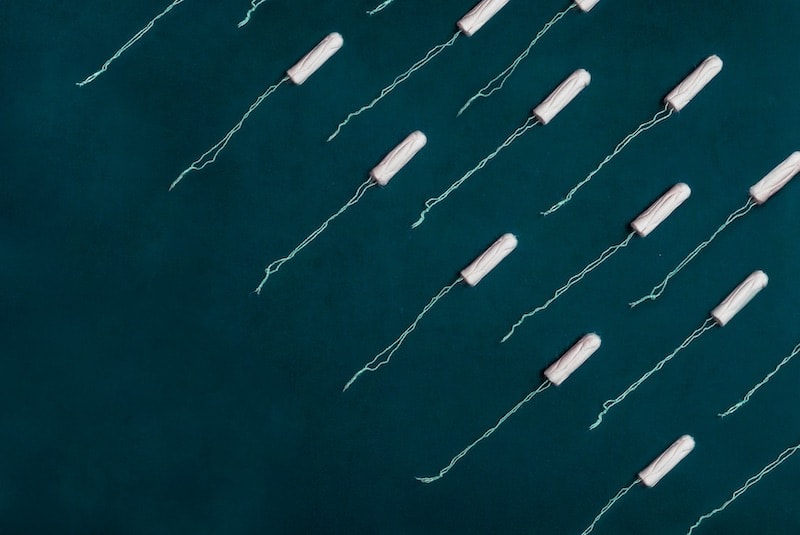
Was ist das Problem mit herkömmlichen Periodenprodukten?
Du hast wahrscheinlich schon Binden und Tampons von bekannten Marken wie Always benutzt – was lustigerweise auch meine Lieblingsmarke als Teenager war. Stell dir meine Überraschung vor, als ich herausfand, dass Always-Binden giftige Chemikalien freisetzen, darunter bekannte krebserregende und fortpflanzungsschädigende Stoffe.
Leider gilt das Gleiche für viele andere herkömmliche Periodenprodukte.
Die meisten gängigen Binden und Tampons werden aus synthetischen Materialien hergestellt und können Spuren von giftigen Chemikalien enthalten. Aktuelle Studien haben einen regelrechten Cocktail an Schadstoffen in konventionellen Menstruationsprodukten nachgewiesen, darunter Phthalate, Dioxine, flüchtige organische Verbindungen, Duftstoffe und sogar Schwermetalle (Women's Voices for the Earth, ScienceDirect Metall-Studie 2024).
Eine 2024 veröffentlichte Peer-Review-Studie fand Schwermetalle in allen 30 getesteten beliebten Tamponmarken – darunter Blei, Arsen und Cadmium (ScienceDirect Metall-Studie). Die Mengen unterschieden sich (Blei war in konventioneller Baumwolle höher; Arsen in einigen Bio-Marken), aber keine Kategorie war komplett frei von Schadstoffen.
Giftige Chemikalien in herkömmlichen Periodenprodukten
Kannst du glauben, dass mehr als zwei Dutzend Studien giftige Chemikalien in Menstruationsprodukten nachgewiesen haben?! Der Umstieg auf nachhaltige Periodenprodukte könnte dir helfen, schädliche Substanzen wie diese zu vermeiden:
-
Dioxine wurden mit Krebs, Fortpflanzungsproblemen und Hormonstörungen in Verbindung gebracht. Selbst kleine Spuren dieses Nebenprodukts können gefährlich sein, da sich Dioxine im Laufe der Zeit in deinem Körper anreichern können.
-
Phthalate: Mehrere Studien haben diese hormonell wirksamen Stoffe in 90% aller getesteten Menstruationsprodukte gefunden. Eine Studie entdeckte sogar mehrere Phthalate in 100% der analysierten Periodenprodukte!
-
Schwermetalle: Deine Tampons könnten auch mit Schwermetallen belastet sein. Laut einer aktuellen Studie enthielten 100% der getesteten Tampons – einschließlich "biologischer" Produkte – diese Nervengifte.
-
Per- und polyfluorierte Alkylverbindungen (PFAS): Die Verbraucherschutz-Website Mamavation fand PFAS in 48% der getesteten Binden, 22% der Tampons und 65% der Periodenunterwäsche. Diese "Ewigkeits-Chemikalien", die sich im Körper anreichern, wurden mit bestimmten Krebsarten und vielen anderen Gesundheitsproblemen in Verbindung gebracht.
-
Flüchtige organische Verbindungen (VOCs): VOCs, darunter Toluol, Methylenchlorid und Xylol, sind häufig in Tampons und Binden enthalten. Sie wurden mit Hormonstörungen, Nierenschäden und Krebsrisiken in Verbindung gebracht.
-
Pestizide: Denkst du, Baumwolle ist sicherer? Tampons und Binden aus nicht-biologischer Baumwolle könnten Pestizidrückstände enthalten, einschließlich Glyphosat, einem potenziellen Krebserreger.
-
Krebserregende Stoffe: Wenn die Liste nicht schon lang und beunruhigend genug ist: Forschungen zeigen, dass Menstruationsprodukte auch andere potenzielle und bekannte Karzinogene enthalten können, darunter Styrol, Chlorethan, Chloroform und Benzol.
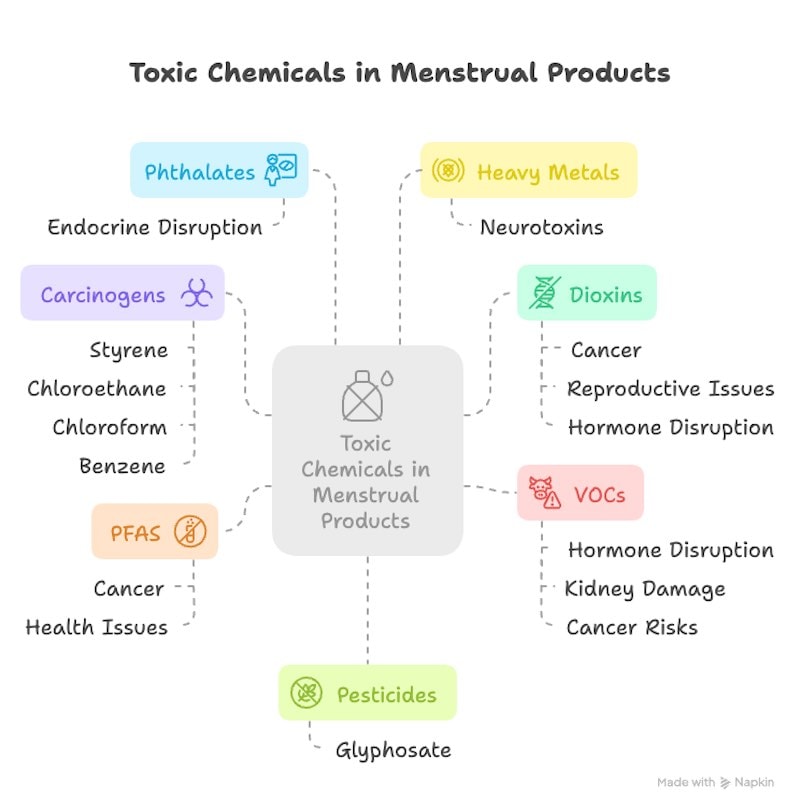
Wie gelangen diese Giftstoffe in deine Periodenprodukte?
Einige sind Nebenprodukte der Herstellung (z.B. Dioxine aus der Chlorbleiche); andere werden absichtlich zugesetzt – wie phthalathaltige Kunststoffe oder Duftstoffe (Women's Voices, NIH-Studie 2023). Verpackungen und Applikatoren führen zusätzliche Chemikalien wie PFAS oder BPA bei.
Rechtliche Lücken in der Sicherheit von Menstruationsprodukten verstehen
Du würdest denken, dass sie strenger reguliert wären, aber überraschenderweise ist das nicht der Fall.
-
Die EU-Richtlinie zur allgemeinen Produktsicherheit verlangt keine Offenlegung der Inhaltsstoffe von Menstruationsprodukten.
-
In den USA reguliert die FDA Binden und Tampons als Medizinprodukte, sodass Hersteller nicht verpflichtet sind, alle Inhaltsstoffe auf dem Etikett anzugeben (KFF Health News 2023). Anwältin Laura Strausfeld bezeichnet den Prozess als "im Grunde genommen nur einen Stempel" (CBS News Interview 2023). Die FDA schreibt Warnhinweise zu TSS und Tests zur Saugfähigkeit vor – aber keine routinemäßigen chemischen Tests oder Offenlegungen.
Es wächst der Druck, diese Transparenzlücke zu schließen. New York (2021) und Kalifornien (2023) haben Gesetze verabschiedet, die die Angabe von Inhaltsstoffen auf Verpackungen von Menstruationsprodukten vorschreiben (KFF Health News). Mehrere andere US-Bundesstaaten haben ähnliche Gesetzentwürfe eingebracht, während der Kongress regelmäßig den "Menstrual Products Right to Know Act" und den "Robin Danielson Act" wieder einbringt.
Angesichts des Mangels an Sicherheitsvorschriften ist die Wahl wirklich nachhaltiger Periodenprodukte extrem wichtig.
Warum nachhaltige Periodenprodukte wählen?
Hier sind die Gründe, warum ich mich für nachhaltige Periodenprodukte entschieden habe und warum du das auch in Betracht ziehen solltest!
Geringeres Risiko von Reizungen und Allergien
Nachhaltige Periodenprodukte vermeiden nicht nur häufige Reizstoffe und Allergene, sondern werden auch aus nachhaltigen Materialien und organischen Naturfasern hergestellt. Bio-Baumwolle und medizinisches Silikon verzichten auf Parfüms und raue Synthetik, wodurch sie schonender zur Haut sind.
Weniger Gesundheitsrisiken
Biologische Menstruationsprodukte helfen dabei, deine Belastung durch schädliche Chemikalien wie PFAS, Schwermetalle und Phthalate zu reduzieren. Denk daran, dass wiederholte Exposition gegenüber diesen Chemikalien – selbst in winzigen Dosen – zu ernsthaften Gesundheitsrisiken führen kann.
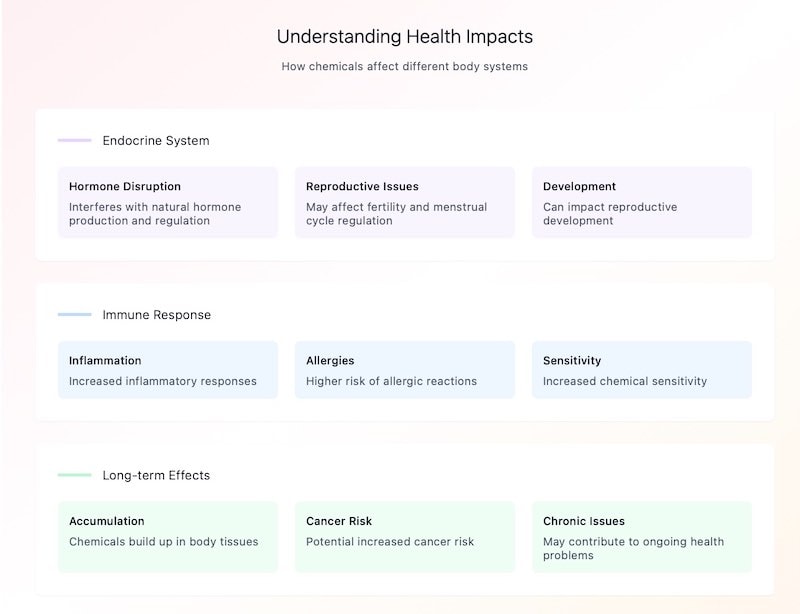
Du fragst dich, welche Menstruationsprodukte am besten für deine Gesundheit sind? Lass uns die sichersten Optionen erkunden!
Welche Periodenprodukte sind am gesündesten?
Ob du Einweg- oder wiederverwendbare Periodenprodukte bevorzugst, es gibt sicherere und nachhaltigere Alternativen zu herkömmlichen, gängigen Marken:
|
Produkt |
Marken die wir empfehlen |
|
Menstruationstassen |
MYLILY*, The Female Company*, Einhorn*, allmatters*, Bamboozy* |
|
Menstruationsscheiben |
|
|
Bio Tampons |
|
|
Schadstofffreie Binden |
MYLILY*, The Female Company*, Natracare*, Cosmea* |
|
PFAS-freie Periodenunterwäsche |
KORA MIKINO*, ooia*, MYLILY*, Yoni*, The Female Company* |
Unsere Top-Auswahl an nachhaltigen Periodenprodukten (getestet und vertrauenswürdig)
Diese Menstruationsprodukte haben unser Vertrauen durch ihre Hingabe zu biologischen, schadstofffreien Materialien, unabhängige Labortests, Zertifizierungen durch Dritte, ethische Herstellung, parfümfreie Formulierungen und zuverlässige, auslaufsichere Leistung gewonnen!
Welches Material ist am sichersten für Menstruationstassen?
Die sicherste und am wenigsten allergieauslösende Wahl für Nutzerinnen wiederverwendbarer Menstruationstassen ist medizinisches Silikon. Dieses Material hat sich als sicher für den menschlichen Kontakt erwiesen – es reagiert nicht mit deinen Körperflüssigkeiten und ist frei von BPA, Latex und Phthalaten. Eine weitere hypoallergene, schadstofffreie Alternative ist medizinisches TPE. Diese beiden Materialien verursachen mit geringerer Wahrscheinlichkeit Reizungen und sind die sichersten Optionen für Menschen mit Latexallergie.
Denk daran, Sterilisation ist entscheidend: Um das Risiko des Toxischen Schocksyndroms (TSS) und anderer Infektionen zu minimieren, sterilisiere deine Menstruationstasse immer durch 5-10-minütiges Abkochen zwischen den Zyklen und wasche deine Hände vor dem Einführen oder Entfernen. Die meisten TSS-Fälle stehen mit unsachgemäßer Reinigung in Verbindung, daher ist die Einhaltung dieser Protokolle für eine sichere Verwendung unerlässlich.
Wichtiger Hinweis: Obwohl Menstruationstassen aus medizinischem Silikon im Allgemeinen als sicher gelten, haben aktuelle unabhängige Tests Spuren von PFAS ("Ewigkeits-Chemikalien") in einigen Marken gefunden – bis zu 21,1 ng/g in seltenen Fällen. Nicht alle Tassen sind PFAS-frei, daher ist es ratsam, Marken zu wählen, die Laborergebnisse von Drittanbietern oder Zertifizierungen vorlegen, die bestätigen, dass ihre Produkte frei von diesen Chemikalien sind.
Geben Menstruationstassen Chemikalien ab?
Menstruationstassen von seriösen Marken geben keine Chemikalien ab. Eine Menstruationstasse besteht typischerweise aus festem medizinischem Silikon und enthält keine zugesetzten Duftstoffe oder versteckten Chemikalien. Du kannst also beruhigt sein, dass deine Menstruationstasse keine schädlichen Substanzen an deinen Körper abgibt!
Menstruationstassen und Menstruationsscheiben
Nachfolgend findest du unsere sorgfältig zusammengestellte Liste nachhaltiger Menstruationstassen und Menstruationsscheiben, damit du deinen Tag verbringen kannst, ohne dir Gedanken über häufiges Wechseln oder schädliche Substanzen machen zu müssen.
Welche Menstruationstassen und Menstruationsscheiben sind schadstofffrei?
MYLILY Menstruationstasse & Disk*
Zertifizierungen: N/A
Materialien: 100% medizinisches Silikon
Preis: 9,95 € - 29,95 €
Warum wir sie mögen:
Nachhaltig & mit Sterilisationsbecher: Die MYLILY Menstruationstasse und Disk sind als deutsches Startup-Produkt besonders auf Qualität und Nachhaltigkeit ausgerichtet. Das weiche, medizinische Silikon bietet ein unvergleichbares Tragegefühl und verursacht keine Reizungen oder Austrocknung der Scheide. Mit einer Haltbarkeit von bis zu 10 Jahren und dem praktischen Transport-Sterilisationsbecher ist MYLILY eine umweltfreundliche Alternative zu herkömmlichen Einwegprodukten. Besonders bemerkenswert ist die flexible Anwendung – die Menstruationsprodukte können beim Sport, Schwimmen und über Nacht verwendet werden und sind auch für Anfängerinnen geeignet.
The Female Company Menstruationstasse*
Zertifizierungen: N/A
Materialien: 100% medizinisches Silikon
Preis: 19,99 €
Warum wir sie mögen:
Von Frauen für Frauen: Diese hochwertige Menstruationstasse wird in Deutschland hergestellt und ist mit dem Dermatest-Siegel "sehr gut" ausgezeichnet. Sie enthält keine Weichmacher, PVC oder BPA und ist für bis zu 12 Stunden Tragedauer konzipiert. Als nachhaltige Alternative zu Einwegprodukten kann sie bei guter Pflege mehrere Jahre verwendet werden. The Female Company setzt sich aktiv für das Brechen von Tabus rund um die Periode ein und bietet auch ein praktisches Starter-Set mit faltbarem Reinigungsbecher an.
Kaufe The Female Company hier*
einhorn Papperlacup Menstruationstasse*
Zertifizierungen: N/A
Materialien: 100% medizinisches Silikon
Preis: 14,99 €
Warum wir sie mögen:
Nachhaltig & fair: Die Papperlacup ist eine weiche, in Deutschland hergestellte Menstruationstasse mit tollem Preis-Leistungs-Verhältnis. Das Berliner Start-up einhorn reinvestiert 50% seiner Profite in soziale Projekte, unterstützt Aufklärungsarbeit und setzt sich für die Enttabuisierung der Periode ein. Mit praktischem Aufbewahrungssäckchen und lustigen Stickern ist sie eine umweltfreundliche Alternative, die weder Geldbeutel noch Schleimhäute belastet.
All Matters Menstruationstasse*
Zertifizierungen: N/A
Materialien: 100% medizinisches Silikon
Preis: 23,99 €
Warum wir sie mögen:
Hypoallergene Qualität: Die All Matters Tasse (früher OrganiCup) ist komplett frei von Bleichmitteln, Klebstoffen, Parfüm und anderen problematischen Stoffen. Mit ihrer bis zu 12-stündigen Auslaufsicherheit und der dreifachen Aufnahmekapazität im Vergleich zu Tampons schont sie das natürliche pH-Gleichgewicht. Das Unternehmen engagiert sich stark für Menstruationsaufklärung, hat bereits über 30.000 Tassen gespendet und bietet eine 90-Tage-Zufriedenheitsgarantie. Sie kommt in drei Größen und mit einer Bio-Baumwolltasche in plastikfreier Verpackung.
Zertifizierungen: N/A
Materialien: 100% medizinisches Silikon
Preis: 18,20 € - 21,10 €
Warum wir sie mögen:
Innovative Entwicklung: Die Bamboozy Menstruationstasse der 3. Generation wurde basierend auf dem Feedback von Hunderten Anwenderinnen perfektioniert. Mit ihrem extra weichen Material, anti-Überlauf-Rand und speziellen Griffmulden bietet sie hervorragenden Komfort und Sicherheit. Sie fasst bis zu 5-mal mehr Flüssigkeit als Tampons, hält bis zu 12 Stunden und wird mit einem praktischen Sterilisator geliefert. In drei Größen erhältlich ist sie eine hygienische, nachhaltige Alternative ohne BPA, Blei oder andere Chemikalien.
cosmundi Menstruationsscheibe*
Zertifizierungen: N/A
Materialien: Medizinisches Silikon
Preis: 19,97 €
Warum wir sie mögen:
Komfort & Freiheit: Die cosmundi Menstruationsscheibe sitzt diskret vor dem Muttermund, anstatt den Vaginalkanal zu füllen, was sie für Sport, Schwimmen und sogar Intimität während der Periode ideal macht. Mit ihrem innovativen Hygienerand ist sie leicht zu reinigen und durch ihre Platzierung werden Menstruationskrämpfe nicht verstärkt. Diese in Deutschland hergestellte, nachhaltige Alternative zu Tampons kann bis zu 10 Jahre halten, schont die Scheidenflora und kommt mit einem praktischen Baumwollbeutel zur Aufbewahrung.
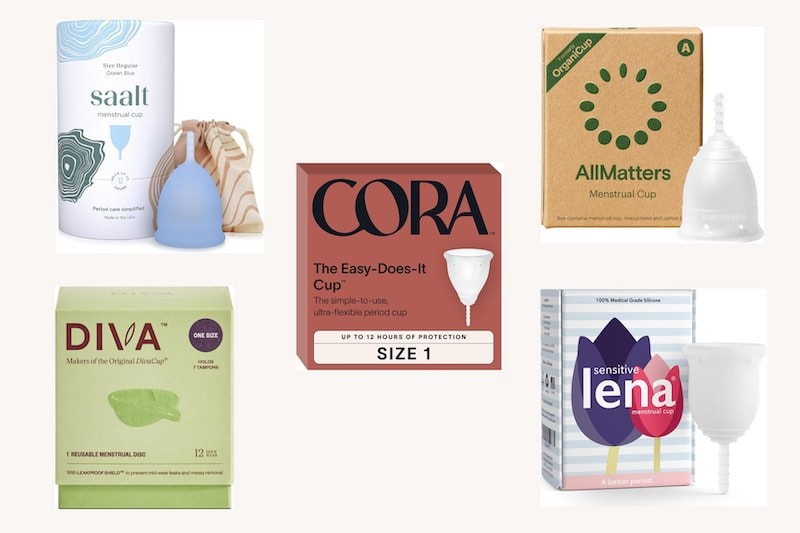
Keine Freundin von wiederverwendbaren Tassen oder Scheiben? Du kannst trotzdem bequeme, schadstofffreie Binden und Tampons finden.
Nachhaltige Bio-Binden und Tampons (Einwegoptionen)
Herkömmliche Binden und Tampons bestehen nicht vollständig aus "reiner Baumwolle", wie gängige Marken oft behaupten. Was sie tatsächlich enthalten, ist eine Mischung aus Materialien, die Folgendes umfassen kann:
-
Plastikkomponenten
-
Chlorgebleichte Materialien
-
Rayon, eine halb-synthetische Faser
-
Nicht-biologische Baumwolle, die möglicherweise Pestizidrückstände enthält
-
SAPs (superabsorbierende Polymere), synthetische Materialien für hohe Saugfähigkeit
-
Duftstoffe oder Farbstoffe, die Hunderte von nicht deklarierten Chemikalien enthalten können
Diese Mischung aus synthetischen Materialien und aggressiven Chemikalien kann deine Haut reizen, Allergien auslösen und sogar dein Hormongleichgewicht stören. Schadstofffreie, biologische Tampons hingegen enthalten weniger Chemikalien und führen laut Frauenarzt Dr. Joan Alvarez mit geringerer Wahrscheinlichkeit zu Reizungen.
Nachhaltige Tampons bestehen im Gegensatz zu herkömmlichen Tampons vollständig aus 100% Bio-Baumwolle.
In ähnlicher Weise verwenden schadstofffreie Binden Bio-Baumwolle oder Pflanzenfasern für die Deckschicht und den Kern und verfügen oft über ein schadstofffreies, pflanzliches Polymer als auslaufsichere Rückseite.
Hier sind einige unserer Lieblings-Binden und Tampons aus nachhaltigen Materialien:
Zertifizierungen: GOTS, MADE SAFE, Soil Association
Materialien: 100% Bio-Baumwolle
Preis: 2,99 € - 16,55 €
Warum wir sie mögen:
Pionier für reine Periodenprodukte: Natracare bietet einige der sichersten Tampons und Binden auf dem Markt. Ihre Produkte bestehen aus 100% reiner Bio-Baumwolle ohne jegliche Zusätze und werden chlorfrei gebleicht, was gefährliche Dioxin-Rückstände verhindert. Das MADE SAFE®-Siegel garantiert die Abwesenheit aller bekannten krebserregenden und hormonell wirksamen Substanzen. Die hypoallergene Zusammensetzung macht diese Produkte ideal für empfindliche Haut und Allergiker, während die vollständig kompostierbare Verpackung ohne Plastik die Umwelt schont. Hier erhältst du höchste Qualität mit den umfassendsten Zertifizierungen.
The Female Company Bio-Tampons & Binden*
Zertifizierungen: N/A
Materialien: 100% Bio-Baumwolle
Preis: Ab 3,89 €
Warum wir sie mögen:
Frauenpower & Qualität: The Female Company bietet hochwertige Periodenprodukte aus 100% Bio-Baumwolle, die in Österreich (Tampons) und Deutschland (Binden) produziert werden. Ihre Tampons kommen in vier verschiedenen Größen mit kompostierbarer Folie, während die Binden in Tag- und Nachtversionen (22,5 cm bzw. 28 cm) mit integrierten Flügeln erhältlich sind. Alle Produkte sind garantiert frei von Chemikalien, Pestiziden und Parfüm, hypoallergen und von Gynäkolog:innen empfohlen.
Kaufe The Female Company hier*
Zertifizierungen: STANDARD 100 by OEKO-TEX, GOTS (Ecocert Greenlife)
Materialien: 100% Bio-Baumwolle, (70% nachwachsende Rohstoffe bei Binden)
Preis: 17,00 € - 24,32 €
Warum wir sie mögen:
Natürlich & hautfreundlich: Die Cosmea Bio-Tampons bestehen aus 100% Bio-Baumwolle mit einer speziellen Rillenstruktur für gleichmäßige Ausdehnung und effiziente Flüssigkeitsaufnahme - ganz ohne Kunstfaser-Umhüllung. Die Maxi-Binden und Ultra Nachtbinden bieten mit ihrer atmungsaktiven, seidenweichen Oberfläche und dem leistungsstarken 3-D Kern bis zu 100% Geruchsschutz und zuverlässigen Seitenauslaufschutz. Alle Produkte werden in Deutschland unter strengsten Umwelt- und Qualitätsrichtlinien hergestellt, sind vegan, dermatologisch mit "sehr gut" bewertet und verwenden überwiegend nachwachsende Rohstoffe.
Zertifizierungen: N/A
Materialien: 100% Bio-Baumwolle
Preis: 4,75 €
Warum wir sie mögen:
Bio-Qualität: Die MYLILY Bio Binden werden in Deutschland hergestellt und bieten einen optimalen Mix aus Nachhaltigkeit und Komfort. Die ultradünnen, langen Binden mit Flügeln sind in zwei Saugstärken für Tag und Nacht erhältlich und bestehen aus 100% Bio-Baumwolle ohne Chlor, Parfüm oder Chemikalien. Besonders beeindruckend ist die plastikfreie Einzelverpackung aus abbaubarer Maisstärke (Mater-Bi). Diese sanften, antiallergen und atmungsaktiven Binden eignen sich hervorragend für empfindliche Haut, Wochenbett, leichte Inkontinenz oder die erste Periode – biologisch abbaubar und vegan produziert.
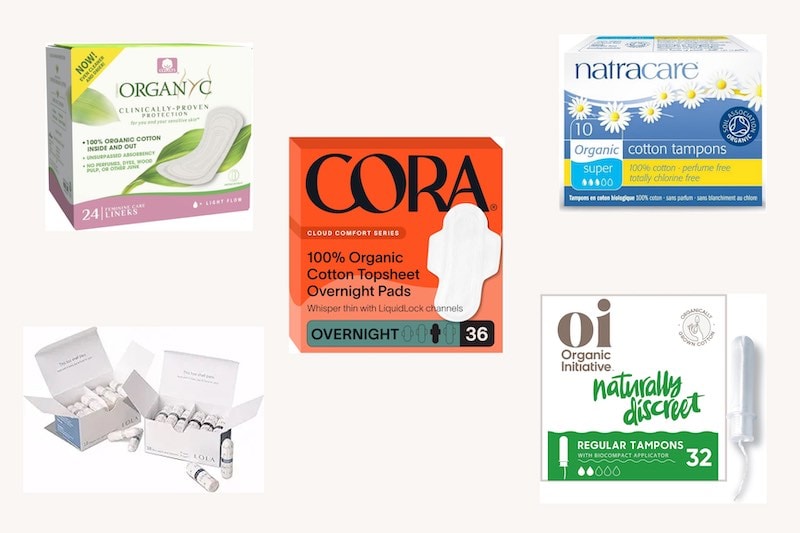
Bevorzugst du eine wiederverwendbare Alternative für leichte Tage oder über Nacht? Periodenunterwäsche könnte die richtige Wahl sein.
Nachhaltige Periodenunterwäsche (Wiederverwendbare absorbierende Unterwäsche)
Periodenunterwäsche ist eine kostengünstige Lösung, um Ersatz-Binden zu ersetzen und Müll zu reduzieren!
Allerdings kann es etwas knifflig sein, eine wirklich schadstofffreie Option zu finden. Forscher vermuten, dass 65% der Periodenunterwäsche PFAS enthalten könnten, eine Gruppe synthetischer Chemikalien, die dein Risiko für Hormon- und Fortpflanzungsprobleme erhöhen können. Bei unserer Suche nach schadstofffreier Periodenunterwäsche haben wir sogar festgestellt, dass Thinx – eine (Amerikanische) Marke, die behauptete, schadstofffrei zu sein – PFAS in ihren Periodenprodukten verwendete.
Glücklicherweise kannst du trotzdem 100% PFAS-freie Periodenunterwäsche finden. Schauen wir uns einige Top-Empfehlungen an, die auf PFAS getestet wurden, natürliche Fasern für die obere Schicht aufweisen und OEKO-TEX-zertifizierte Stoffe verwenden:
KORA MIKINO Periodenunterwäsche*
Zertifizierungen: N/A
Materialien: MicroModal® und Sauglage aus Baumwolle/Lyocell/Polyester-Mix
Preis: 36,95 € - 38,95 €
Warum wir sie mögen:
Unsichtbarer Komfort: Die innovativen Periodenslips von KORA MIKINO sind nahtlos konzipiert und hinterlassen selbst unter engen Leggings keine Abdrücke. Mit einer Saugstärke von bis zu 30 ml (entspricht drei mittleren Tampons) bieten sie auch bei stärkerer Blutung zuverlässigen Schutz. Das Besondere: Ihr dehnbares, anpassungsfähiges Material in Doppelgrößen passt sich dem Körper optimal an und schneidet nicht ein. Nachhaltig aus MicroModal® hergestellt und unter fairen Bedingungen in Europa gefertigt, können die Slips nach dem Ausspülen in der Waschmaschine gereinigt und immer wieder verwendet werden – eine umweltfreundliche Alternative zu Einwegprodukten.
Zertifizierungen: N/A
Materialien: Baumwolle, Merinowolle, integriertes Membransystem
Preis: 34,95 € - 44,95 €
Warum wir sie mögen:
Vielfalt mit Stil: ooia überzeugt mit einer beeindruckenden Produktpalette von Slips über Hipster bis zu Strings in Größen 32-54, sowohl nahtlos als auch mit eleganter Spitze oder sportlichem Design. Das clevere Membransystem bietet je nach Modell Schutz von "light" bis "extra strong" und ist absolut auslaufsicher gegen Blut, Ausfluss und Schweiß. Besonders angenehm ist die Verwendung von atmungsaktiver, mulesing-freier Merinowolle, die für ein frisches Gefühl sorgt. Die Unterwäsche ist pflegeleicht - einfach kurz ausspülen und bei 40 Grad waschen - und bietet eine nachhaltige Alternative zu Einwegprodukten ohne Kompromisse bei Stil und Funktionalität.
Zertifizierungen: Global Organic Textile Standard (GOTS)
Materialien: 100% GOTS-zertifizierter Bio-Baumwolle
Preis: Ab 34,95 €
Warum wir sie mögen:
Natürlich & bequem: Die MYLILY Periodenunterwäsche kombiniert nachhaltigen Umweltschutz mit optimalem Komfort durch die Verwendung von weicher Bio-Baumwolle innen und außen. Die verschiedenen Modelle bieten zuverlässigen Schutz und können sowohl als alleiniger Schutz als auch als zusätzliche Sicherheit zu Tampons oder Menstruationstassen getragen werden. Die auslaufsicheren Slips sind auch für leichte Inkontinenz sowie in der Schwangerschaft und im Wochenbett geeignet. Das deutsche Start-up legt besonderen Wert auf Nachhaltigkeit und Qualität - die Unterwäsche lässt sich einfach bei 30 Grad waschen und immer wieder verwenden.
Zertifizierungen: Global Organic Textile Standard (GOTS)
Materialien: 94% Bio-Baumwolle mit spezieller Saugschicht
Preis: 32,50 € - 35,50 €
Warum wir sie mögen:
Schönes Design & kaum spürbar: Die Periodenunterwäsche von Yoni besteht aus superweicher, zertifizierter Bio-Baumwolle mit einer hauchdünnen, effektiven Saugschicht. Erhältlich in verschiedenen Styles, darunter Bikini und High Waist mit recyceltem Mesh, fühlt sie sich wie normale Unterwäsche an und bietet dennoch zuverlässigen Schutz für bis zu drei mittelgroße Tampons. Die High Waist-Variante schmeichelt allen Körperformen und bietet erhöhten Komfort durch die anschmiegsame Passform. Einfach unter fließendem Wasser ausspülen, bei maximal 40 Grad waschen (ohne Weichspüler) und an der Luft trocknen lassen – für eine nachhaltige, wiederverwendbare Alternative zu Einwegprodukten.
The Female Company Periodenunterwäsche*
Zertifizierungen: Global Organic Textile Standard (GOTS)
Materialien: 95% Bio-Baumwolle mit biologisch abbaubaren Saugschichten
Preis: 34,95 € - 39,95 €
Warum wir sie mögen:
Hohe Saugkraft & Komfort: Die Period Pantys von The Female Company beeindrucken mit ihrer innovativen 4-lagigen "Stay Dry Layer" Technologie, die bis zu 6 Tampons aufnehmen kann, ohne ein Nässegefühl zu hinterlassen. Trotz der hohen Saugkraft sind sie nur 1mm dicker als normale Unterwäsche. Die äußeren Schichten aus weicher, zertifizierter Bio-Baumwolle umschließen eine Kombination aus schnelltrocknender Oberfläche, absorbierender Membran und wasserdichter Schicht – alle aus biologisch abbaubaren oder recycelten Materialien. Das von Frauen gegründete Unternehmen bietet eine nachhaltige Alternative, die Geld und Müll spart.
Kaufe The Female Company hier*
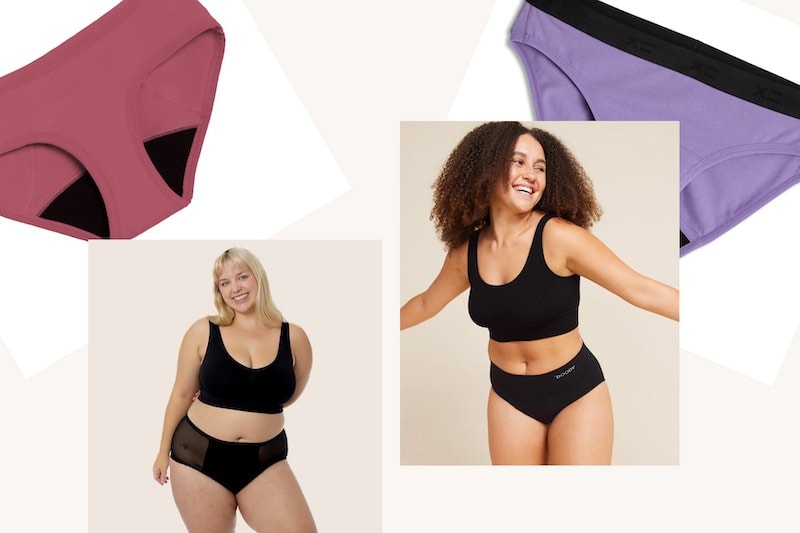
Worauf du bei sicheren und nachhaltigen Periodenprodukten achten solltest
Wenn du nach sicheren, schadstofffreien Periodenprodukten suchst, behalte diese Kriterien im Hinterkopf:
|
Must-have |
Warum es wichtig ist |
|---|---|
|
Zertifizierte Bio-Baumwolle (GOTS, OEKO-TEX oder Fair Trade) |
Angebaut ohne synthetische Pestizide; verarbeitet ohne Chlorbleiche |
|
Medizinisches Silikon |
Inert, BPA-frei, latexfrei, ohne Auslaugung von Schadstoffen |
|
Frei von Duft- und Farbstoffen |
Vermeidet Phthalate/Allergene, die in "Duftstoffen" versteckt sind |
|
Keine PFAS / minimaler Kunststoff |
Reduziert die Belastung durch "Ewigkeits-Chemikalien" und Mikroplastik |
|
Siegel von Dritten - MADE SAFE®, OEKO-TEX® Standard 100 |
Unabhängige Untersuchung auf Hunderte von Schadstoffen |
|
Volle Transparenz |
Marken, die alle Inhaltsstoffe auflisten, haben nichts zu verbergen |
Wichtiger Hinweis zu PFAS in Bio-Produkten: Eine Studie aus dem Jahr 2023 fand PFAS in 22% der getesteten Tampons – einschließlich einiger, die als biologisch gekennzeichnet waren. Das bedeutet, dass während eine Bio-Zertifizierung (wie GOTS) sicherstellt, dass die Baumwolle ohne Pestizide angebaut wurde, sie nicht garantiert, dass das Produkt PFAS-frei ist. Achte immer auf Marken, die PFAS-Testergebnisse oder Zertifizierungen von Drittanbietern für ihre fertigen Produkte bereitstellen. Die OEKO-TEX® STANDARD 100-Zertifizierung ist ein starker Indikator dafür, dass ein Produkt auf Hunderte von schädlichen Substanzen getestet wurde, einschließlich PFAS und Schwermetalle.
Die wichtigsten Erkenntnisse
-
Herkömmliche Marken können PFAS, Schwermetalle und andere Giftstoffe verstecken – überprüfe daher das Etikett, bevor du kaufst.
-
Vaginalgewebe nimmt Inhaltsstoffe schnell auf; je weniger Chemikalien du dort platzierst, desto besser.
-
Greife zuerst zu zertifizierter Bio-Baumwolle oder medizinischem Silikon, immer ohne Duftstoffe.
-
Achte auf vertrauenswürdige Siegel von Drittanbietern (GOTS, OEKO-TEX®, MADE SAFE®), um Sicherheitsangaben zu überprüfen.
-
Beginne mit einem einfachen Austausch – jede Veränderung verringert deine chemische Belastung und deinen Plastikmüll.
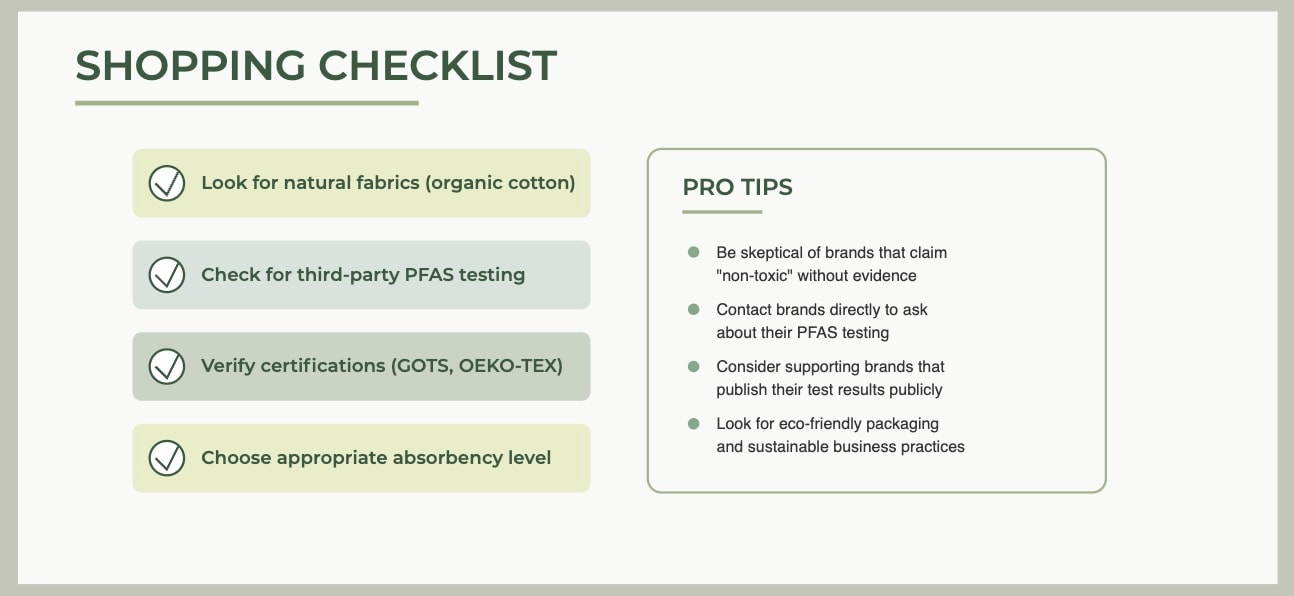
FAQ zu nachhaltigen Periodenprodukten
Was ist die gesündeste Option für die Periode?
Die gesündeste Option für die Periode hängt von deinen individuellen Bedürfnissen ab, aber Menstruationstassen aus medizinischem Silikon gelten oft als eine der besten Wahl. Sie sind frei von zugesetzten Chemikalien, stören nicht das vaginale Gleichgewicht und sind sowohl umweltfreundlich als auch kostengünstig. Wenn Tassen für dich nicht angenehm sind, sind Bio-Baumwoll-Binden oder Tampons und vertrauenswürdige Periodenunterwäsche ebenfalls ausgezeichnete schadstofffreie Alternativen. Viele finden, dass eine Kombination am besten funktioniert, wie z.B. die Verwendung einer Tasse tagsüber und Bio-Binden oder Periodenunterwäsche nachts. Letztendlich ist die gesündeste Wahl diejenige, die schadstofffrei ist, zu deinem Lebensstil passt und sich angenehm anfühlt, um sie konsequent zu verwenden.
Welche Binden haben keine Chemikalien?
Bio-Baumwollbinden ohne synthetische Zusatzstoffe, Duftstoffe, Chlorbleiche oder Plastikkomponenten gelten generell als die am wenigsten toxische Einweg-Option für Menstruationsbinden. Studien haben besorgniserregende Chemikalien wie PFAS ("Ewigkeits-Chemikalien") in vielen herkömmlichen Menstruationsprodukten gefunden, wobei irreführende "natürliche" und "schadstofffreie" Etiketten für Verwirrung bei Verbrauchern sorgen, die sicherere Alternativen suchen. Wiederverwendbare Stoffbinden aus Bio-Baumwolle, Hanf oder Bambus bieten chemikalienfreie Alternativen, die auch den Umweltabfall reduzieren. Für Einweg-Optionen, suche nach 100% Bio-Baumwollbinden, die ungebleicht (oder ohne Chlor verarbeitet), parfümfrei sind und Transparenz über ihre Materialien und Herstellungsprozesse bieten. Unternehmen, die sich auf Nachhaltigkeit und Gesundheitsbewusstsein konzentrieren, produzieren eher wirklich schadstofffreie Menstruationsbinden mit minimalen chemischen Zusatzstoffen.
Geben Menstruationstassen Chemikalien ab?
Hochwertige Menstruationstassen aus medizinischem Silikon, TPE (thermoplastischer Elastomer) oder Gummi geben bei normaler Verwendung in der Regel keine Chemikalien an den Körper ab. Medizinisches Silikon, das häufigste Tassenmaterial, ist speziell darauf ausgelegt, biologisch inert, nicht reaktiv mit Körpergewebe und bei Körpertemperatur stabil zu sein. Im Gegensatz zu einigen Einwegprodukten, die PFAS, Dioxine oder andere bedenkliche Chemikalien enthalten können, sind ordnungsgemäß hergestellte Menstruationstassen frei von BPA, Phthalaten, Kunststoffen, Bleichmitteln und Farbstoffen. Diese inerte Eigenschaft macht Menstruationstassen zu einer günstigen Option für diejenigen, die sich Sorgen über chemische Belastung während der Menstruation machen. Allerdings spielt die Qualität eine wesentliche Rolle - Tassen sollten immer von seriösen Herstellern gekauft werden, die ihre Materialien und Fertigungsstandards nachweisen können.
Welches Material ist für eine Menstruationstasse am sichersten?
Medizinisches Silikon gilt weithin als das sicherste Material für Menstruationstassen, wie seine lange Geschichte der Verwendung in medizinischen Geräten belegt, die Biokompatibilität mit menschlichem Gewebe erfordern. Dieses Material ist hypoallergen, unterstützt kein Bakterienwachstum, kann wiederholtes Abkochen zur Sterilisation standhalten und behält seine strukturelle Integrität über viele Jahre der Nutzung bei. TPE (thermoplastischer Elastomer) ist eine weitere sichere Option, die etwas weicher als Silikon ist und von Personen mit Empfindlichkeiten bevorzugt werden kann, obwohl es typischerweise eine kürzere Lebensdauer hat. Natürlicher Gummi ist ein alternatives Material, das in einigen Tassen verwendet wird, sollte aber von Personen mit Latexallergien vermieden werden. Unabhängig vom Material ist der Kauf von etablierten Herstellern, die ihre Produkte auf Biokompatibilität testen und Transparenz über ihre Materialien bieten, wesentlich für die Sicherheit.
Ist eine Menstruationstasse zu 100% sicher?
Obwohl Menstruationstassen bei richtiger Anwendung ein ausgezeichnetes Sicherheitsprofil haben, kann kein Menstruationsprodukt für jede Person zu 100% sicher garantiert werden. Forschungen zeigen, dass Menstruationstassen eine sehr geringe Inzidenz von Komplikationen aufweisen, wobei Studien ein minimales Risiko für genitale Entzündungen oder Infektionen bei richtiger Reinigung und Verwendung zeigen. Zu ihren Sicherheitsvorteilen gehören ein verringertes Risiko für Toxisches Schocksyndrom im Vergleich zu Tampons, das Fehlen chemischer Zusatzstoffe und die Vermeidung von Mikroabschürfungen, die bei saugfähigen Produkten auftreten können. Jedoch können bestimmte Faktoren die individuelle Sicherheit beeinflussen: richtige Größenwahl, Einführtechnik, Reinigungsprotokolle und Entleerungshäufigkeit sind alle wichtig, um mögliche Komplikationen zu vermeiden. Für die meisten Nutzerinnen stellen Menstruationstassen eine der sichersten verfügbaren Optionen dar, aber wie bei jedem intimen Produkt sollten persönliche Faktoren wie anatomische Variationen und bestehende Gesundheitszustände berücksichtigt werden.
Welche Schadstoffe sind in Tampons und Binden enthalten?
In konventionellen Tampons und Binden wurden durch zahlreiche Studien bedenkliche Stoffe wie Dioxine (Krebserreger), Phthalate (hormonell wirksame Stoffe), Schwermetalle (Blei, Arsen), PFAS (Ewigkeitschemikalien), flüchtige organische Verbindungen und Pestizide nachgewiesen, die über die Schleimhäute direkt in den Körper gelangen können und mit gesundheitlichen Risiken wie Hormonstörungen, verminderte Impfwirksamkeit und sogar Krebsrisiken in Verbindung gebracht werden - besonders problematisch, da die vaginalschleimhaut stoffe schneller aufnimmt als die haut.
Welche Alternativen gibt es zu Tampons?
Es gibt zahlreiche nachhaltige Periodenprodukte als Alternative zu Tampons: Menstruationstassen aus medizinischem Silikon (wie von MYLILY, The Female Company oder Allmatters), Menstruationsscheiben (wie von cosmundi oder MYLILY), schadstofffreie Bio-Binden aus GOTS-zertifizierter Baumwolle (z.B. von Natracare oder MYLILY) sowie PFAS-freie Periodenunterwäsche (von Marken wie KORA MIKINO, ooia oder Yoni) - diese Alternativen sind nicht nur gesünder für den Körper und reduzieren die Chemikalienbelastung, sondern schonen auch die Umwelt durch weniger Müll und bieten oft mehr Tragekomfort.
1 Kommentar
World Rehabilitate Clinic has made a great impact treating and providing complete cure for patients with chronic illnesses.













